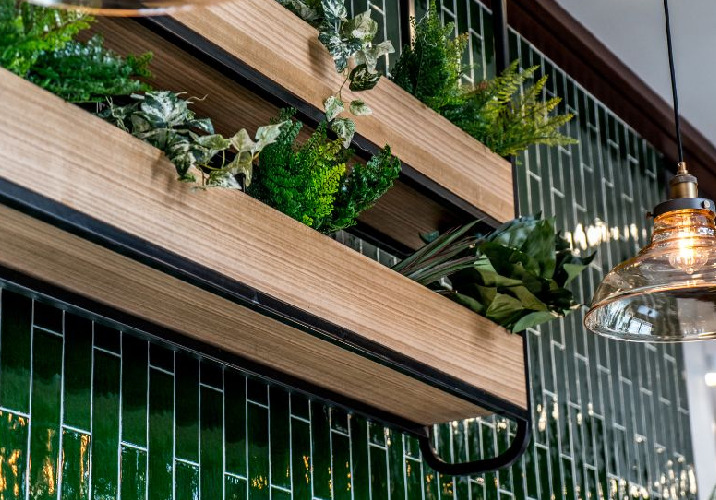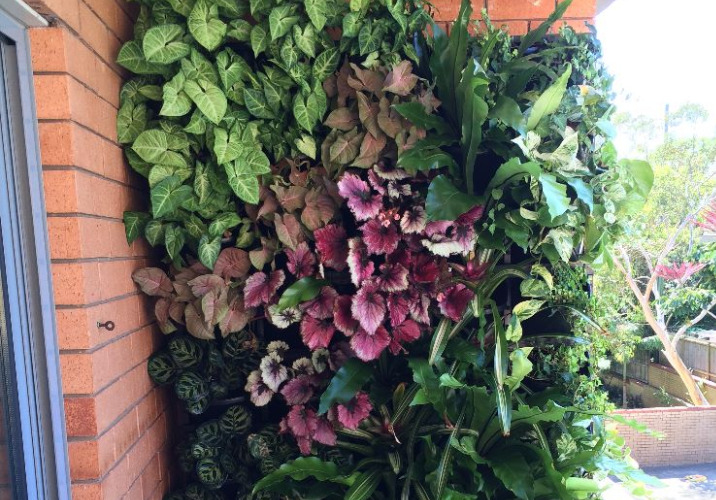
Find a local gardener
- Inspiration /
- Outdoor projects /
- Gardening & landscaping /
- Vertical garden ideas...
Vertical garden ideas for small spaces
How to make a vertical garden in any space in your home
Want a great way to bring a garden onto a balcony or into a small space? Consider cultivating a vertical garden. These pieces of living artwork are often much lower maintenance than the conventional garden, but still require work to ensure that they remain at their best. They are relatively easy to set up with many vertical garden kits available on the market.
What is a vertical garden?
As the name suggests, vertical gardens grow upwards, as opposed to flat or over a horizontal area. There are so many vertical garden ideas that are possible such as a climbing plant up your wall, hanging baskets comprising blossoms and plants or a “green wall.” In a vertical garden wall, felt pockets are filled with various plants and then attached to a frame, which in turn is affixed to a wall. These types of gardens are great as they do not need as much space as your standard garden.

Why vertical gardens are ideal for apartment living and small spaces
When living in an apartment, you likely have very little room overall to have the traditional ground-based garden. Yet, for this type of garden, all you need is an outside wall. You can grow flowers that cascade your balcony or even grow a vertical herb garden for you to use and enjoy.
Unlike a traditional garden, this type is easy to grow. It does not require as much maintenance as other gardens. The automated watering system you will use will feed the plants and there is only some occasional pruning and trimming for you to do to encourage growth.
One of the things that apartments lack the most is a connection to nature. Instead of seeing nothing but concrete when looking out your window or people surrounding your home, this allows you to have a much better view. You’ll be able to enjoy the beauty of the vertical garden by just stepping outside for a moment.
Ideas for setting up a DIY vertical garden
Choose the right location
It’s important to choose an area with ample sunlight, but not so much so that they are constantly drying out. Look for an area that gets no less than six hours of sunlight each day, usually on the north or northeasterly area of the garden. Otherwise, choose plants that do best in shaded areas.
Know what plants are best
It is just as important to choose the right plants for your home. For a vertical garden, select plants that will do well in this type of area. Choose a plant that has the right root system as well, such as those that do not have a vigorously growing root system. Some of the types of flowers that will do well in this environment include roses, sweet pea, jasmine, wisteria, marigolds, petunias, and nasturtiums. You will also want to choose plants to group together that need the same types of nutrients and watering. This helps keep the entire process easier for you to manage. Also, it helps ensure a fabulously full flowering garden.
Potting mix choices
In the event that you require soil for your vertical garden, you need to ensure that it is of the best quality with the maximum amount of nutrients so as to promote the healthy growth of your plants. Remember to always ensure that you use a great calibre mix. An ideal would include slow-release fertilisers and soil wetting agents. It is vital for potting soil to be comprised of soil wetting agents as these prevent the soil from becoming too dry between the times that you water it.
The potting soil should also be able to drain adequately to prevent the soil from clogging with unnecessary moisture. Remember that too much moisture in the soil could result in rotten roots and fungi. You should also preferably opt for a lightweight potting mix. This is imperative for a bigger vertical garden as you will need to ensure that your supports are strong enough to withstand the weight of both your soil and plants.

Providing nutrients
Since the majority of vertical gardens do not use much soil, it is critical to add nutrients with the water. These can be delivered through a gravity-fed drip irrigation system, so ensure that the drippers do not contain blockages and that the nutrients are maintained. Most nurseries have the nutrients you will need.
At its most simple level, vertical gardening can simply involve hanging a pot on a balcony wall, or it can be as complex as a drip-fed wall installation. The latter is based upon the concept of hydroponics, which involves growing plants using very little, or even no, soil, and relying on water that is rich in nutrients. A vertical garden site on a wall will usually comprise a framed and fibrous sheet of hessian or felt (or another similar material) fixed onto the wall onto which the plants will be sewn.
A water system will then trickle down water automatically, irrigating the plants. This water can then be recycled, making it a highly environmentally friendly system. There are various other techniques that can be taken advantage of with limited vertical space, including using plastic columns, tubes, or cylinders. With this technique, several holes are inserted along a column in which the plants grow. A more conventional method, however, is to plant boxes on stands or beds to achieve the same effect. It is important, however, that you give yourself access to the site for occasional maintenance.
Maintaining a vertical garden
Regardless of the type of plant selected (ferns, flowers, herbs, succulents, veggies), they each require specific care. For instance, pruning and trimming your plants is a must for those that bear fruit or flowers. Dead leaves or flowers must be removed in an appropriate amount of time. Pruning is also important so they grow a specific way. Keep in mind that vertical gardens are still subject to unwanted pests, so make sure to look out for insects. Additionally, constantly check the plants for any indication of disease. If you see some, use natural products to eliminate the disease.
Related posts
How much will your job cost?
The Oneflare Cost Guide Centre is your one-stop shop to help you set your budget; from smaller tasks to larger projects.



